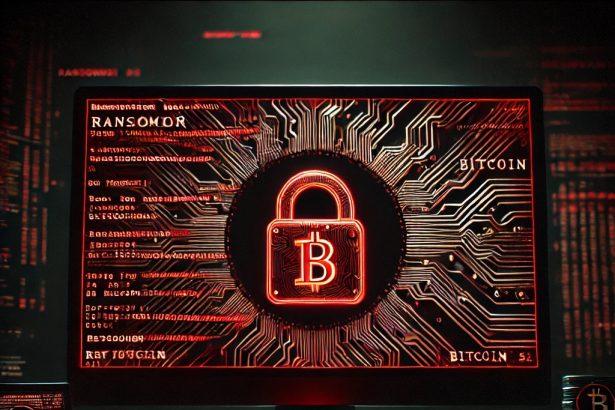Moscovium is a ransomware-type malware that encrypts victims’ files and demands a ransom in Bitcoin to unlock them. Once inside the system, it adds the “.m0sC0v1um” extension to encrypted files — making them completely inaccessible without a decryption tool that only the cybercriminals supposedly possess. For example, a file like report.pdf becomes report.pdf.m0sC0v1um.
This malware not only disrupts file access but also intimidates victims by displaying a full-screen message and leaving behind a ransom note named “!!!DECRYPT_INSTRUCTIONS!!!.txt” on the desktop. Victims are told to pay 0.1 BTC(over $8,000 at the time of writing) and email proof of payment to the attackers at m0sc0v1um@tutanota.com.
Threat Summary
| Attribute | Details |
|---|---|
| Threat Name | Moscovium Ransomware |
| Threat Type | Ransomware, Crypto Virus, File Locker |
| Encrypted File Extension | .m0sC0v1um |
| Ransom Note File Name | !!!_DECRYPT_INSTRUCTIONS_!!!.txt |
| Ransom Amount | 0.1 BTC (Bitcoin) |
| Wallet Address | bc1qxy2kgdygjrsqtzq2n0yrf249ndw0w2u5gq4p4g |
| Contact Email | m0sc0v1um@tutanota.com |
| Free Decryptor Available? | No |
| Detection Names | Avast (FileRepMalware [Inf]), Combo Cleaner (Trojan.GenericKD.75733035), ESET-NOD32 (A Variant Of MSIL/Filecoder.BII), Kaspersky (HEUR:Trojan-Ransom.MSIL.Encoder.gen), Microsoft (Ransom:Win32/Genasom) |
| Symptoms | Files renamed with .m0sC0v1um, inaccessible files, ransom message on screen and desktop |
| Damage | File encryption, possible theft of sensitive data, potential additional malware payloads |
| Distribution Methods | Malicious email attachments, pirated software, torrent websites, drive-by downloads, fake updates |
| Danger Level | High |
Text of the Ransom Note
vbnetCopyEdit== YOUR FILES ARE ENCRYPTED ==
Send 0.1 BTC to: bc1qxy2kgdygjrsqtzq2n0yrf249ndw0w2u5gq4p4g
Email proof to: m0sc0v1um@tutanota.com
== DO NOT ATTEMPT DECRYPTION YOURSELF ==
Moscovium Ransomware Overview
This malware behaves like other ransomware families such as Mamona, VanHelsing, and SuperBlack, but with its own twist in encryption and extortion. Once encryption is complete, it informs the victim through a fullscreen window and leaves behind a plain-text ransom note. Unfortunately, there’s no free decryptor available for Moscovium, and paying the ransom does not guarantee recovery — many victims never receive the promised decryption tool.
Moscovium is distributed using phishing techniques, malicious attachments, trojans, and shady websites. Simply opening an infected file — be it a PDF, archive, executable, or script — can trigger the attack. This is why it’s crucial to stay away from pirated content, crack tools, and unsolicited email attachments.
This ransomware can also drop additional payloads, such as password-stealing trojans, intensifying the risk of identity theft or further infections.
Manual Ransomware Removal Process
Important: Manual removal is recommended only for experienced users, as incorrect actions can lead to data loss or incomplete removal of the ransomware. If unsure, consider the SpyHunter Removal Method for a guided, automated solution.
Step 1: Disconnect from the Internet
- Immediately disable Wi-Fi or unplug the Ethernet cable to prevent the ransomware from communicating with remote servers.
- This can prevent additional encryption or further infections.
Step 2: Boot into Safe Mode
For Windows Users
- Windows 10/11:
- Press Windows + R, type
msconfig, and press Enter. - Under the Boot tab, select Safe boot and check Network.
- Click Apply, then OK, and restart your PC.
- Press Windows + R, type
- Windows 7/8:
- Restart your PC and press F8 repeatedly before Windows starts.
- Select Safe Mode with Networking and press Enter.
For Mac Users
- Restart your Mac and hold the Shift key immediately after the startup chime.
- Release the key when the Apple logo appears.
- Your Mac will boot in Safe Mode.
Step 3: Identify and Terminate Malicious Processes
Windows
- Open Task Manager by pressing Ctrl + Shift + Esc.
- Look for unusual processes consuming high CPU or memory.
- Right-click on the suspicious process and select End Task.
Mac
- Open Activity Monitor (Finder > Applications > Utilities > Activity Monitor).
- Look for unknown or high-resource-consuming processes.
- Select the suspicious process and click Force Quit.
Step 4: Delete Ransomware Files
Windows
- Open File Explorer and navigate to:
C:\Users\[Your Username]\AppData\LocalC:\Users\[Your Username]\AppData\RoamingC:\Windows\System32
- Identify and delete suspicious files (randomly named or recently modified items).
- Clear temporary files:
- Press Windows + R, type
%temp%, and hit Enter. - Delete all files in the Temp folder.
- Press Windows + R, type
Mac
- Open Finder and select Go > Go to Folder.
- Type
~/Library/Application Supportand check for unfamiliar files or folders. - Remove unknown
.plistfiles from~/Library/LaunchAgents.
Step 5: Remove Ransomware Entries from Registry or System Settings
Windows
- Press Windows + R, type
regedit, and hit Enter. - Navigate to:
HKEY_CURRENT_USER\SoftwareHKEY_LOCAL_MACHINE\Software
- Identify and delete ransomware-related registry entries.
Mac
- Open System Preferences > Users & Groups.
- Select the Login Items tab and remove any unknown startup programs.
- Check
~/Library/Preferencesfor malicious settings.
Step 6: Restore System Using a Backup or Restore Point
Windows
- Press Windows + R, type
rstrui, and press Enter. - Choose a restore point from before the infection and proceed.
Mac
- Restart your Mac and enter macOS Utilities by holding Command + R.
- Select Restore from Time Machine Backup and restore a safe backup.
Step 7: Attempt to Decrypt Files
- Check No More Ransom (www.nomoreransom.org) for available decryption tools.
- If unavailable, restore files from backups.
Automated Ransomware Removal with SpyHunter
If manual removal is too complex or risky, SpyHunter offers a safer, automated method for detecting and removing ransomware.
Step 1: Download SpyHunter
- Get SpyHunter from the official Enigma Software website.
Step 2: Install SpyHunter
- Open the downloaded file (
SpyHunter-Installer.exeor.dmgfor Mac users). - Follow the installation prompts.
- Launch SpyHunter upon completion.
Step 3: Run a Full System Scan
- Click Start Scan Now to detect malware and ransomware.
- Wait for the scan to complete and review detected threats.
Step 4: Remove Detected Ransomware
- Click Fix Threats to remove identified ransomware components.
- SpyHunter will clean your system automatically.
Step 5: SpyHunter’s Custom Malware HelpDesk
- If ransomware persists, use SpyHunter’s Malware HelpDesk for custom malware fixes.
Step 6: Restore Files
- Use backups stored on external drives or cloud storage.
- If no backup is available, check No More Ransom for decryption tools.
Preventing Future Ransomware Attacks
- Keep backups: Use cloud storage or an external hard drive.
- Install a reliable security tool: SpyHunter offers real-time protection against malware.
- Enable Windows Defender or Mac security features for additional protection.
- Avoid phishing emails and unknown attachments.
- Regularly update Windows, macOS, and installed applications.




